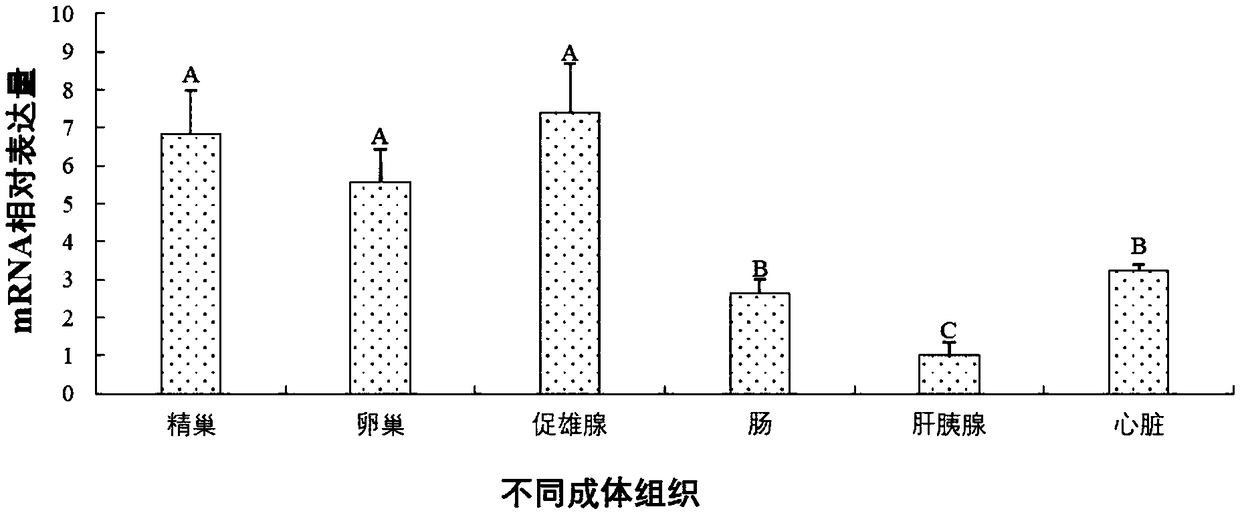GEM gene of Macrobrachium nipponense and encoding protein and application thereof
A 5GEM-R2, gene technology, applied in the green shrimp GEM gene and its encoded protein and application fields, achieving significant economic value and application prospects
- Summary
- Abstract
- Description
- Claims
- Application Information
AI Technical Summary
Problems solved by technology
Method used
Image
Examples
Embodiment 1
[0027] Example 1: Obtaining the full-length cDNA of the freshwater shrimp GEM gene
[0028] Total RNA extraction: Select 10 healthy and mature male freshwater shrimp androgenic glands, quickly put them into a pre-cooled mortar filled with liquid nitrogen, and grind them quickly. Total RNA was extracted using RNAiso Plus extraction reagent from Takara Company combined with the traditional phenolic extraction method, and the extraction method was referred to the instruction manual. The quality of the RNA was detected by agarose gel electrophoresis, and the OD260 / 280 ratio of the sample was analyzed by a spectrophotometer to be between 1.8 and 2.0, and the concentration of the RNA was determined.
[0029]The middle fragment sequence of GEM gene cDNA was obtained from the transcriptome of the androgenic gland of freshwater shrimp. According to the sequence of the middle fragment of GEM gene cDNA, design specific forward primers 3GEM-F1 (SEQ ID NO:3), 3GEM-F2 (SEQ ID NO:4); and re...
Embodiment 2
[0030] Embodiment 2: Green shrimp GEM gene tissue expression
[0031] Based on the nucleotide sequence of SEQ ID NO:1, within the open reading frame, NCBI online primer design software ( http: / / www.ncbi.nlm.nih.gov / tools / primer-blast / ) to design and prepare primers (SEQ ID NO:7-SEQ ID NO:8) for fluorescent quantitative PCR of the green shrimp GEM gene. Tissues such as testis, androgenic gland, ovary, hepatopancreas, intestine, and heart (N≥3) were obtained from healthy and mature freshwater shrimp, and the tissues were preserved in RNA preservation solution (Takara). The total RNA of each tissue was extracted as described in Example 1, and the total RNA was reversed into cDNA using the iScriptTM cDNA Synthesis Kit perfect Real Time (Bio-Rad) kit, and the Bio-Rad iCycler iQ5 fluorescent quantitative PCR analysis system was used to detect the presence of the GEM gene in Relative expression levels in each tissue of freshwater shrimp. Such as figure 1 As shown, the expression...
Embodiment 3
[0032] Embodiment 3: In situ hybridization research of freshwater shrimp GEM gene
[0033] Based on the nucleotide sequence of SEQ ID NO:1, the in situ hybridization sense probe sequence and antisense probe sequence of the green shrimp GEM gene were designed and prepared within the open reading frame using Primer5 primer design software, and commissioned by Shanghai Sangong Bioengineering Co., Ltd. (Sangon) synthesized sense in situ hybridization probes and antisense in situ hybridization probes (SEQ ID NO: 9-SEQ ID NO: 10) labeled with a Digoxigenin signal. The testis, androgenic gland and hepatopancreas were obtained from healthy and mature male freshwater shrimp, and preserved in 4% paraformaldehyde solution for fixation. Frozen sections of each tissue were prepared. The Zytofast PLUS CISH Implementation kit (Zyto Vision GmBH, Germany) was used to perform histological localization of each tissue, and the localization results were observed under a microscope. Such as fig...
PUM
 Login to View More
Login to View More Abstract
Description
Claims
Application Information
 Login to View More
Login to View More - R&D
- Intellectual Property
- Life Sciences
- Materials
- Tech Scout
- Unparalleled Data Quality
- Higher Quality Content
- 60% Fewer Hallucinations
Browse by: Latest US Patents, China's latest patents, Technical Efficacy Thesaurus, Application Domain, Technology Topic, Popular Technical Reports.
© 2025 PatSnap. All rights reserved.Legal|Privacy policy|Modern Slavery Act Transparency Statement|Sitemap|About US| Contact US: help@patsnap.com


